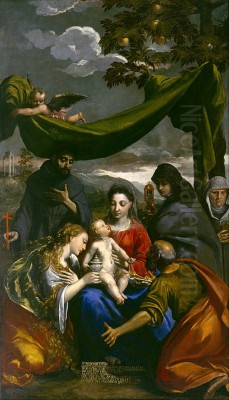
Ippolito Scarsella, more famously known by his diminutive nickname "Scarsellino," stands as a significant figure in Italian art history, particularly within the context of the late Renaissance and early Baroque periods in Ferrara. Active during the latter half of the 16th and the first two decades of the 17th century, Scarsellino carved a unique niche for himself, skillfully blending the rich artistic traditions of Venice with the distinct sensibilities of his native Emilia-Romagna. His prolific output spanned religious narratives, mythological scenes, and evocative landscapes, leaving an indelible mark on the School of Ferrara and influencing subsequent generations of artists.
Early Life and Formative Influences
Born in Ferrara around 1550 or 1551, Ippolito Scarsella entered a world already steeped in artistic heritage. His father, Sigismondo Scarsella (c. 1530–1614), known as "il Mondino," was himself a painter and architect of modest renown. This familial connection undoubtedly provided the young Ippolito with his earliest exposure to artistic practice and theory. Sigismondo likely imparted foundational skills to his son, nurturing the nascent talent that would eventually blossom into a distinguished career. Ferrara itself, under the Este court, had fostered a vibrant artistic environment, home to earlier masters like Cosimo Tura, Francesco del Cossa, and Ercole de' Roberti, whose legacy formed the bedrock of the Ferrarese school.
Seeking broader horizons and more advanced training, Scarsellino ventured beyond Ferrara. His journey led him first to Bologna, a major artistic center in Emilia, where he could absorb the influences of painters navigating the transition from High Renaissance ideals to Mannerist complexities. Figures like Pellegrino Tibaldi were active in Bologna, and the city was soon to become the crucible for the Carracci reform. This period likely broadened Scarsella's technical repertoire and exposed him to different approaches to composition and expression.
The Venetian Sojourn: Embracing Colorito
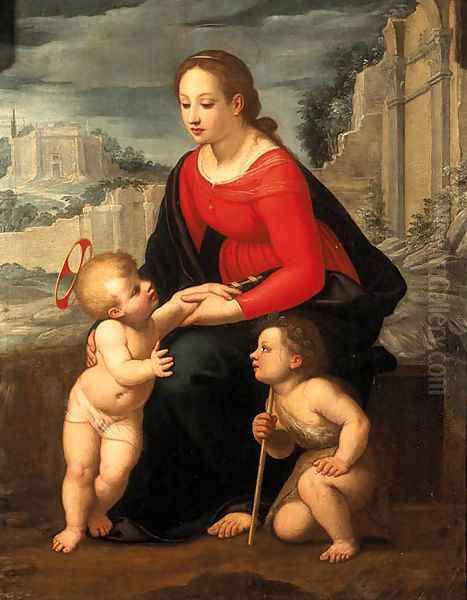
A pivotal phase in Scarsellino's development occurred during his extended stay in Venice, which is believed to have lasted approximately four years, likely beginning around 1570. This immersion in the heart of the Venetian school proved transformative. He entered the bustling workshop of Paolo Veronese (Paolo Caliari), one of the titans of 16th-century Venetian painting. Working alongside Veronese exposed Scarsellino directly to the principles of colorito – the Venetian emphasis on color, light, and painterly brushwork as primary means of expression. Veronese's opulent scenes, characterized by luminous palettes, dynamic compositions, and a sense of theatrical grandeur, left a lasting impression on the young Ferrarese artist.
Beyond Veronese's direct tutelage, Scarsellino absorbed the broader atmosphere of Venetian art. He studied the works of other masters who defined the era: the profound emotional depth and atmospheric sfumato of Giorgione, the revolutionary use of color and dramatic intensity of Titian (Tiziano Vecellio), and the vibrant, often rustic, genre scenes and religious narratives of Jacopo Bassano and his prolific family workshop. The influence of the Ferrarese painter Dosso Dossi, who himself had strong ties to Venice and whose work often featured fantastical landscapes and rich color, also resonated with Scarsellino's developing style. This Venetian experience fundamentally shaped his approach to color, light, and atmospheric effects.
Return to Ferrara: Synthesis and Collaboration
Upon returning to Ferrara, Scarsellino established himself as a leading painter in the city. He brought back the lessons learned in Venice, particularly the emphasis on rich color and dynamic light, and began integrating them with the Ferrarese tradition, which often favored more linear definition and expressive intensity. His workshop became highly productive, fulfilling numerous commissions for churches, confraternities, and private patrons throughout Ferrara and the surrounding region.
A significant aspect of his Ferrarese career involved his interaction and collaboration with the Carracci family, who were spearheading a reform movement aimed at revitalizing Italian painting by drawing from nature and the High Renaissance masters, while rejecting the perceived artificiality of late Mannerism. Scarsellino is known to have worked alongside Ludovico Carracci and possibly Annibale Carracci, particularly on decorations for the Palazzo dei Diamanti in Ferrara. This interaction was likely mutually beneficial; Scarsellino's Venetian-inflected style, particularly his handling of color and light, is thought to have influenced Ludovico Carracci. Conversely, the Carracci's emphasis on naturalism and clear narrative structure may have also informed Scarsellino's work.
Artistic Style and Technique: A Fusion of Traditions

Scarsellino's mature style is characterized by a sophisticated synthesis of diverse influences. From Venice, he retained a love for warm, often jewel-like colors, atmospheric lighting, and a relatively fluid brushstroke. His paintings frequently exhibit a soft interplay of light and shadow, creating depth and mood without resorting to the stark, dramatic contrasts (chiaroscuro) associated with Caravaggio, although some later works might show a subtle awareness of Caravaggism's impact, perhaps encountered during visits to Rome.
From his Emilian roots, particularly the legacy of artists like Parmigianino and Correggio (though Correggio's influence might be more indirect), Scarsellino incorporated a sense of grace, elegance, and often a sweet, sentimental emotionality, especially in his depictions of the Madonna and Child or the Holy Family. His figures, while grounded, often possess a refined quality. The Ferrarese tradition contributed a certain narrative clarity and sometimes an intensity of expression.
His compositions are typically well-structured, balancing figures and space effectively. While capable of complex multi-figure scenes, he excelled particularly in smaller-scale works, often cabinet pictures intended for private devotion or contemplation. His technique involved careful layering of glazes to achieve luminosity and depth of color, combined with more direct painting for highlights and details, resulting in surfaces that are both rich and refined.
Thematic Range: Sacred, Secular, and Landscape
Scarsellino was remarkably versatile in his subject matter. Religious themes formed the core of his production, catering to the demands of the Counter-Reformation era. He painted numerous altarpieces and devotional images, frequently depicting the Madonna and Child in various combinations – with the infant St. John the Baptist, with saints, or surrounded by angels. The Holy Family was another recurrent subject, often shown in tender, intimate moments or during the Flight into Egypt, a theme that allowed for the inclusion of landscape elements. Larger narrative scenes, such as the Supper in the House of Simon or the Massacre of the Innocents, showcased his ability to handle complex compositions and dramatic storytelling.
Mythological and secular subjects also feature in his oeuvre, reflecting the tastes of sophisticated patrons. He depicted scenes like the Bath of Venus, Venus and Adonis, Diana and Endymion, and the complex narrative of Salmacis and Hermaphroditus. These works often allowed for a focus on the idealized nude figure set within lush landscapes, blending classical themes with his characteristic painterly style.
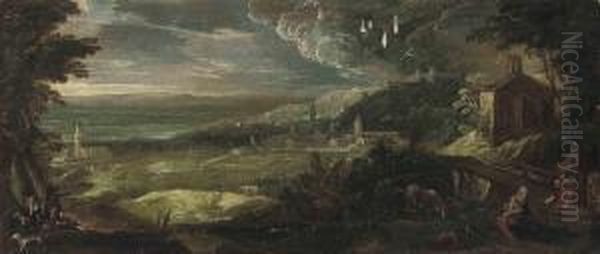
Scarsellino made a notable contribution to the development of landscape painting. While often serving as backdrops for religious or mythological narratives, his landscapes possess a distinct character. They frequently feature expansive vistas, rolling hills, atmospheric skies, and carefully observed details of nature, demonstrating an affinity for the pastoral tradition influenced by Venetian painters like Titian and Giorgione, but also anticipating the more structured landscapes of the 17th century. His small figures are often enveloped by these evocative natural settings, creating a sense of harmony or poignant isolation.
Representative Works and Collections
Scarsellino's prolific output ensures his presence in numerous major museums and collections across Italy and internationally. Some of his key works include:
Galleria Borghese, Rome: This museum holds a significant group of Scarsellino's works, showcasing his versatility. Notable examples include Madonna and Child with the Infant John the Baptist, the mythological scenes Salmacis and Hermaphroditus, Bath of Venus, Diana and Endymion, and Venus and Adonis. These works highlight his skill in depicting both religious tenderness and classical sensuality, often within rich landscape settings.
Uffizi Gallery, Florence: The Uffizi houses important works such as the Virgin and Child with Saints Peter and Paul and the Judgment of Paris, demonstrating his ability in both traditional altarpiece formats and complex mythological narratives.
National Gallery, London: The Holy Family with Saint John and the Lamb is a fine example of his devotional paintings, showcasing the characteristic sweetness and warm palette influenced by his Venetian training.
Galleria Nazionale d'Arte Antica (Palazzo Barberini), Rome: This gallery holds the Supper in the House of Simon, a large narrative work notable for its complex composition and also for its past attribution history.
Pinacoteca Nazionale, Ferrara: As expected, his native city's gallery holds a collection of his works, providing context within the Ferrarese school.
Many other paintings reside in churches in Ferrara and Emilia-Romagna, as well as in museums like the Pinacoteca di Brera (Milan), the Louvre (Paris), and various collections in the United States and elsewhere. His smaller devotional panels and landscapes were particularly sought after by collectors.
Lost Works and Attribution Challenges
Like many artists of his era, Scarsellino's oeuvre is not without its complexities. Attribution issues occasionally arise, as demonstrated by the Supper in the House of Simon, which was once attributed to Veronese before being correctly assigned to Scarsellino. This reflects the high quality of his work and his successful assimilation of Venetian styles, which could sometimes lead to confusion with his masters or contemporaries.
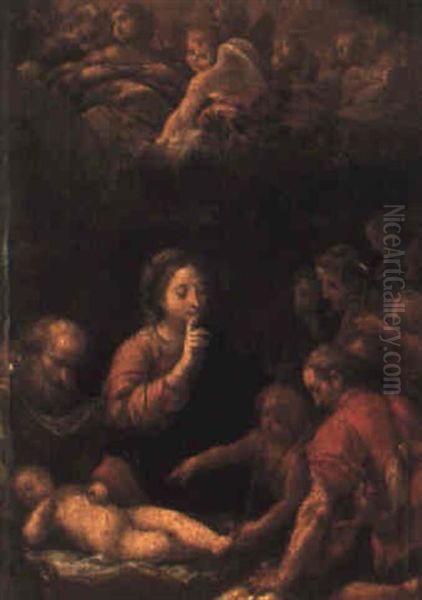
Tragically, not all of Scarsellino's works have survived. The destruction wrought by World War II claimed several important pieces. Notably, two paintings, believed to be a Flight into Egypt and a Holy Family at the Altar (or similar subjects sometimes referred to as The Exodus), were lost during the devastating bombing of Dresden in 1945, where they were housed in the Gemäldegalerie Alte Meister. These losses represent irreplaceable gaps in his artistic legacy.
Legacy and Influence: A Bridge Between Eras
Ippolito Scarsella died in Ferrara in 1620. He left behind a substantial body of work and a significant legacy within the Ferrarese school. He is often seen as one of the last great exponents of the Ferrarese tradition initiated by Tura and Cossa, but also as a crucial transitional figure who absorbed the innovations of the late 16th century, particularly from Venice, and helped pave the way for the Baroque.
His influence extended to subsequent generations. His handling of landscape and his integration of figures within atmospheric settings likely inspired later Emilian artists. Figures associated with the Bolognese school, such as Guido Reni and particularly Guercino (Giovanni Francesco Barbieri), whose early work shows an interest in rich color and painterly effects, may have looked towards Scarsellino's example. His documented pupil, Costanzo Cattani, carried on his workshop traditions, though without achieving the same level of distinction.
Scarsellino's reputation endured, particularly among collectors. His works, especially the smaller cabinet pictures, became popular items, finding their way into prominent collections across Europe. Sources suggest a particular appreciation among British collectors, indicating his appeal within the "Anglo-Saxon world," where his blend of devotional sentiment and painterly richness found favour.
Scholarly Reception and Conclusion
In contemporary art history, Scarsellino is recognized as a talented and important painter, a key figure in the artistic landscape of Ferrara and Emilia-Romagna at the turn of the 17th century. Scholarly research continues to explore the nuances of his style, his relationship with contemporaries like the Carracci, and his specific contributions to religious iconography and landscape painting. While perhaps not possessing the revolutionary impact of a Caravaggio or an Annibale Carracci, his ability to synthesize diverse artistic currents – Venetian color, Emilian grace, Ferrarese expression – into a coherent and appealing personal style marks him as a significant master.
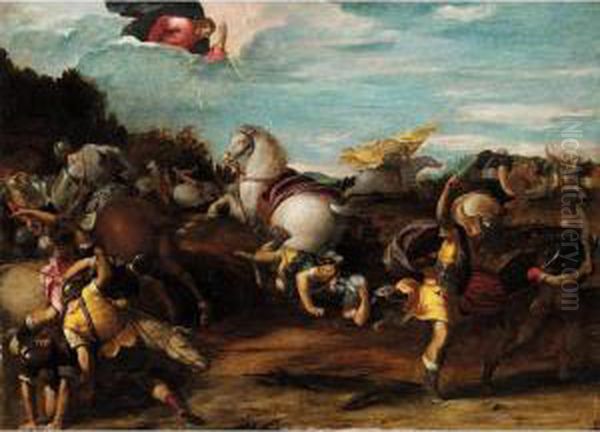
His art represents a bridge between the late Mannerist period and the emerging Baroque, characterized by its warmth, sensitivity, and technical refinement. Ippolito Scarsella, "Scarsellino," remains a testament to the enduring vitality of regional Italian schools and the complex interplay of influences that shaped European art during a period of profound transformation. His paintings continue to engage viewers with their gentle piety, mythological charm, and evocative depictions of the natural world, securing his place as a respected master of the Ferrarese school.